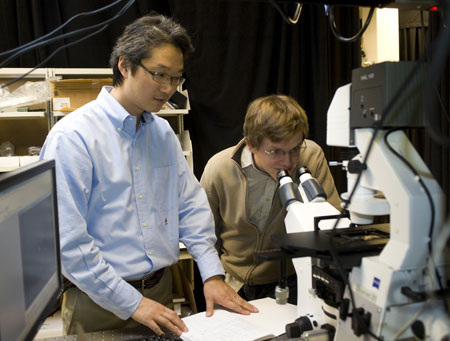 Researchers are creating a new type of solar cell designed to self-repair like natural photosynthetic systems in plants by using carbon nanotubes and DNA, an approach aimed at increasing service life and reducing cost.
Researchers are creating a new type of solar cell designed to self-repair like natural photosynthetic systems in plants by using carbon nanotubes and DNA, an approach aimed at increasing service life and reducing cost.
Jan 4th, 2011
Read more
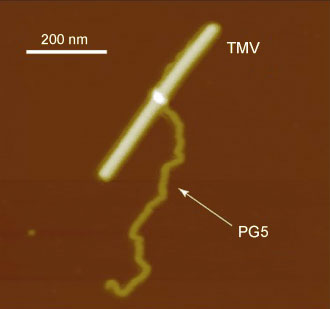 Organic Chemists have always been trying to imitate biology. Although it is possible to make many molecules that imitate biomolecules in terms of structure and function, it remains a challenge to attain the size and form of large biomolecules. An international team at the ETH Zurich has now introduced a branched polymer that resembles the tobacco mosaic virus in size and cylindrical form.
Organic Chemists have always been trying to imitate biology. Although it is possible to make many molecules that imitate biomolecules in terms of structure and function, it remains a challenge to attain the size and form of large biomolecules. An international team at the ETH Zurich has now introduced a branched polymer that resembles the tobacco mosaic virus in size and cylindrical form.
Jan 4th, 2011
Read more
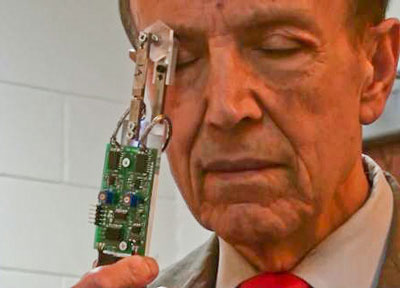 Cumbersome glaucoma tests that require a visit to the ophthalmologist could soon be history thanks to a home test. The self-test instrument has been designed in Eniko Enikov's lab at the UA College of Engineering. Gone are the eye drops and need for a sterilized sensor. In their place is an easy-to-use probe that gently rubs the eyelid and can be used at home.
Cumbersome glaucoma tests that require a visit to the ophthalmologist could soon be history thanks to a home test. The self-test instrument has been designed in Eniko Enikov's lab at the UA College of Engineering. Gone are the eye drops and need for a sterilized sensor. In their place is an easy-to-use probe that gently rubs the eyelid and can be used at home.
Jan 4th, 2011
Read more
Muscheln sind wahre Klebekuenstler. Ob am Holz eines Stegs, am Metall eines Schiffrumpfes, an Steinen oder an einem Artgenossen, sie haften ueberall. Forschern um Philip B. Messersmith von der Northwestern University ist es nun gelungen, einen der 'Universal-Klebstoffe' von Muscheln nachzuahmen.
Jan 4th, 2011
Read more
 The new material, dubbed a 'nanoscoop' because its shape resembles a cone with a scoop of ice cream on top, can withstand extremely high rates of charge and discharge that would cause conventional electrodes used in today's Li-ion batteries to rapidly deteriorate and fail. The nanoscoop's success lies in its unique material composition, structure, and size.
The new material, dubbed a 'nanoscoop' because its shape resembles a cone with a scoop of ice cream on top, can withstand extremely high rates of charge and discharge that would cause conventional electrodes used in today's Li-ion batteries to rapidly deteriorate and fail. The nanoscoop's success lies in its unique material composition, structure, and size.
Jan 4th, 2011
Read more
TU Delft professor of process intensification, Andrzej Stankiewicz, has received an ERC Advanced Investigators Grant of 2.3 million euros from the European Research Council. Professor Stankiewicz will use the money to carry out research on improving chemical reactions at the molecular level in the next five years.
Jan 4th, 2011
Read more
Proceedings of the IEEE cites potential for spin-based technology to replace static RAM.
Jan 4th, 2011
Read more
EU-funded scientists in the Netherlands have managed to rapidly control the building blocks of a quantum computer by using an electric field rather than a magnetic one. In addition, the team succeeded in embedding these building blocks, known as quantum bits or qubits, in a semiconductor nanowire.
Jan 4th, 2011
Read more
A five-year, $16-million grant from the National Cancer Institute will take advantage of specialized expertise developed by scientists at Albert Einstein College of Medicine of Yeshiva University and Montefiore, the University Hospital and Academic Medical Center for Einstein.
Jan 4th, 2011
Read more
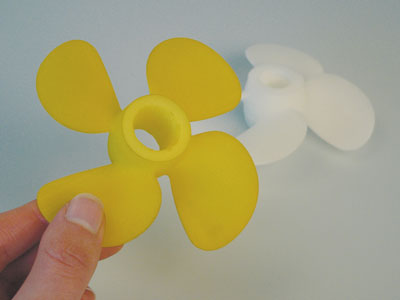 Researchers at the Fraunhofer Institute for Environmental, Safety and Energy Technology UMSICHT in Oberhausen are pursuing a new idea by testing how carbon dioxide can be used to impregnate plastics.
Researchers at the Fraunhofer Institute for Environmental, Safety and Energy Technology UMSICHT in Oberhausen are pursuing a new idea by testing how carbon dioxide can be used to impregnate plastics.
Jan 3rd, 2011
Read more
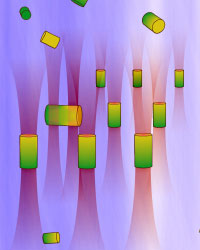 A few months ago Muenster scientists showed that certain molecules - so-called nano-containers - can be guided by light alone. This study has now been singled out for special praise.
A few months ago Muenster scientists showed that certain molecules - so-called nano-containers - can be guided by light alone. This study has now been singled out for special praise.
Jan 3rd, 2011
Read more
At January's TEDxCaltech conference, researchers will present a one-molecule robot capable of following a trail of chemical breadcrumbs.
Dec 30th, 2010
Read more
Distinguished Prof. Kwang-Lung Lin of the Department of Materials Science and Engineering at National Cheng Kung University (NCKU), Tainan, Taiwan, the Deputy Executive Director of Industrial Technology Research Institute (ITRI) South, has received the honorary title of 2011 Institute of Electrical and Electronics Engineers (IEEE) Fellow with his outstanding achievement on the research of lead-free solder alloy and its material response, and also won the title of 2010 Materials Research Society Taiwan (MRS-T) Fellow.
Dec 29th, 2010
Read more
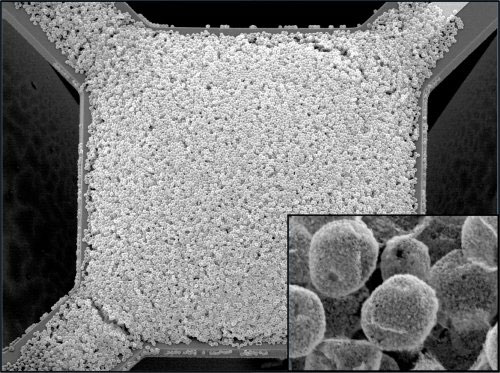 Researchers have overcome a fundamental obstacle in developing breath-analysis technology to rapidly diagnose patients by detecting chemical compounds called 'biomarkers' in a person's respiration in real time.
Researchers have overcome a fundamental obstacle in developing breath-analysis technology to rapidly diagnose patients by detecting chemical compounds called 'biomarkers' in a person's respiration in real time.
Dec 28th, 2010
Read more
Five new US, European and Japanese companies join A*STAR's Industrial Consortium On Nanoimprint to engineer marine life-inspired anti-microbial surfaces for use on ships, lenses and medical devices.
Dec 28th, 2010
Read more
 NEC Corporation announced that it succeeded in the world's first simulation-based prediction of laser-induced photochemical reactions that can efficiently eject a hydrogen atom from a hydrogen chloride molecule trapped inside a carbon nanotube.
NEC Corporation announced that it succeeded in the world's first simulation-based prediction of laser-induced photochemical reactions that can efficiently eject a hydrogen atom from a hydrogen chloride molecule trapped inside a carbon nanotube.
Dec 28th, 2010
Read more
 Researchers are creating a new type of solar cell designed to self-repair like natural photosynthetic systems in plants by using carbon nanotubes and DNA, an approach aimed at increasing service life and reducing cost.
Researchers are creating a new type of solar cell designed to self-repair like natural photosynthetic systems in plants by using carbon nanotubes and DNA, an approach aimed at increasing service life and reducing cost.







 Subscribe to our Nanotechnology News feed
Subscribe to our Nanotechnology News feed